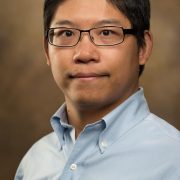An Accidental Invention Could Lead to Easier Methods of Screening Drugs and Toxins

Bending DNA makes it more susceptible and sensitive to the presence of silver ions. Experimental results show that silver ions negatively affect the base-pair matching of DNA, resulting dissociation of the bent DNA bows. Illustrations by the University of Arkansas.
Almost every cell in the bodies of humans and other living organisms contains DNA, which encodes genetic instructions. Damage to DNA from toxins can have serious effects on health, while other chemicals can facilitate DNA stability and repair. Information on the interactions between DNA and other chemicals could help scientists develop new preventative measures and treatments for diseases such as cancer, but few existing techniques are sensitive enough to study these interactions, and the ones that are sensitive enough are very expensive.
Jack Freeland, a physics major and Honor College student, and assistant professor Yong Wang have developed a method to study the interactions between DNA and other chemicals more easily, using equipment and techniques readily available in most chemistry and biochemistry labs.
Freeland and Wang have shown that bent pieces of DNA, which they call DNA amplifiers, could be used to observe interactions of DNA with metal ions using gel electrophoresis. They have published a study demonstrating proof of concept for this method using magnesium and silver ions, and they have filed a patent for their method. They plan to investigate interactions between DNA and other chemicals, with an eventual goal of developing a method to screen DNA targeting drugs, including cancer treatments. Their discovery could also have applications in monitoring water quality.
As a doctoral student at UCLA, Wang and his colleagues developed a technique to bend DNA in order to study the effects of mechanical forces on proteins. DNA has a double helix structure that is formed from two strands of paired molecules, or bases. Wang started with two single strands of synthesized DNA, a longer one and a shorter one. When mixed together and heated, the bases of the two strands pair up so the ends of the longer strand bend toward the middle of the shorter strand and form a circular construction.
Wang and Freeland discovered by accident that these structures can be used to observe interactions between DNA and other chemicals. While using the bent pieces of DNA to study the behavior of proteins, the researchers changed the composition of the buffer solution in which the DNA pieces self-assembled. When they removed magnesium ions from this solution, it had an observable effect on the way the DNA assembled. The researchers knew that in the presence of magnesium, the DNA would form more stable structures than it did when the magnesium was removed, because magnesium is known to have a stabilizing effect on DNA. However, they did not expect the effect to be large enough be observed in low concentrations of magnesium without expensive equipment. The researchers realized they had found a way to amplify this effect, and they decided to test other applications of this discovery.
As physicists, Freeland and Wang recognized that the bent DNA amplified the effects of the magnesium ions because bending the molecule change its “energy landscape,” which is a well-known concept in the field of physics. DNA, a system made up of molecules held together by molecular bonds, has an energy landscape that determines how it is affected by mechanical and chemical forces. Bending the strands of DNA places stress on the molecular bonds, which changes this landscape and allows the effects of ions and other chemicals to be amplified.

In this analogy, the collisions (interactions) between marble balls and wooden sticks are of interest. If the collisions are weak enough, the sticks rarely crack, producing “low signals.” In contrast, after applying stress and pre-bending the sticks so they are close to breaking, collisions result in more cracked sticks, generating “higher signals.” Although bending the sticks does not change their interactions with the balls, it makes the signals much easier to be observed. In other words, bending “amplifies” the signals.
Wang compared the bent DNA to wooden sticks. “If you have a bunch of sticks, and you throw a ball at them, a few of the sticks will crack,” he said. “On the other hand, if you bend the sticks so they are close to being cracked, then when you throw the ball at them, the number of cracked sticks will be higher and the effects will be easier to observe.”
Using concepts of mechanics and physics to study biological systems like DNA is a relatively new and promising approach. “Mechanical methods are particularly appealing,” said Wang, “Because mechanical methods are universal in the sense that they do not depend on the exact type and details of the involved chemical and biochemical systems and reactions. Therefore, it is of great interest to make use of mechanical energies and forces for controlling chemical, biochemical, and biological reactions, with significant progresses in the past three decades.”
In their study, Freeland and Wang observed the behavior of the self-assembling strands of DNA in the presence of magnesium and silver ions. They compared strands of DNA that were designed to self-assemble into bent shapes with a control group of DNA designed to self-assemble the usual way. The researchers used gel electrophoresis, a routine and inexpensive technique, to observe how many strands of DNA were able to bind together and what kind of structures were formed.

Two single-stranded DNA oligos with different lengths are designed. The left segment of the long strand (blue) hybridizes to the left half of the short sequence (red), while the right segment of the long strand hybridizes to the right half of the short sequence, leaving the middle segment of the long sequence unhybridized. Upon hybridization, this will produce a bent double-stranded DNA (containing a nick), while the single-stranded part is stretched.
When the DNA was exposed to magnesium ions, the researchers could observe that the stabilizing effect of the ions promoted the release of energy in the bent DNA molecules, straightening them and forming the more stable structures that Freeland observed in the other experiment. On the other hand, the control DNA had no observable differences in the presence of magnesium.
When the researchers exposed the DNA to silver ions, they observed that the presence of silver ions affected the ability of the DNA bases to pair up into the bent structures. As a result, gel electrophoresis revealed more single strands and fewer hybridized strands in the bent DNA and silver mixture, an effect that was too small to be observed on non-bent strands of DNA.
Freeland, who is working on this project as part of his honors thesis, explained he wanted to work in Wang’s lab because he saw that the projects there could make a difference in the world. The opportunity to perform research and publish a paper has enhanced his experience as an undergraduate. “I was looking specifically for research that I saw that could have either short-term or immediate effects on people’s lives,” he said. “When I started it was typical, trying to get my thesis done and trying to graduate, but as the projects involved and I’ve spent more and more time on it it’s actually become more of a career influencer on me.”






You must be logged in to post a comment.